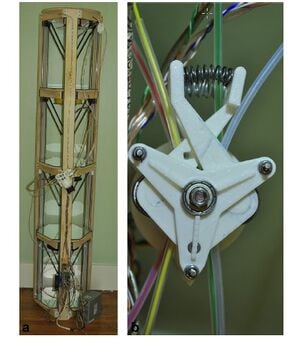Open-source, self-replicating 3-D printer factory for small-business manufacturing

Additive manufacturing with 3-D printers may be a key technology enabler for entrepreneurs seeking to use disruptive innovations such as business models utilizing distributed manufacturing. Unlike centralized manufacturing, distributed manufacturing makes the parts and products (the prints) at (or closer to) the source of the demand, cutting out much of the traditional supply chain. Although many expect 3-D printing to take off at the household level and previous work has shown significant returns for those choosing to do so, there are still significant barriers to entry for typical consumers. Our analysis demonstrates that for an individual to make an abnormally high return on their investments in 3-D printers, they must serve others to achieve high utilization rates. The impetus to do so is created by a service that can undercut traditionally manufactured products due to affordability and customizability. Low-cost, open-source 3-D printers are now priced within range of individual entrepreneurs who can take advantage of the long tail of consumers with highly varied interests. The margin advantage, net present value, and return on investment (ROI) analysis provided herein could form the basis of thousands of new small-business ventures in the coming years.
- The BOM in Appendix A and B: https://osf.io/52sxp/
- To build follow the basic parameters from Athena Build Overview substituting in the larger sections from the BOM and repeating 4x
- Latest version of Delta OpenSCAD code and Tool effector OpenSCAD code
- To see the delta in action see MOST quad delta RepRap
- Operate with Franklin open source software
See also[edit | edit source]
- Multi-material additive and subtractive prosumer digital fabrication with a free and open-source convertible delta RepRap 3-D printer
- Global value chains from a 3D printing perspective
- Business Models for Open Source Hardware Repositories
- Economic Impact of DIY Home Manufacturing of Consumer Products with Low-cost 3D Printing from Free and Open Source Designs
- Making the Tools to Do-It-Together: Open-source Compression Screw Manufacturing Case Study
- Emergence of Home Manufacturing in the Developed World: Return on Investment for Open-Source 3-D Printers
- Impact of DIY Home Manufacturing with 3D Printing on the Toy and Game Market
- Mobile Open-Source Solar-Powered 3-D Printers for Distributed Manufacturing in Off-Grid Communities
- Distributed Manufacturing of Flexible Products- Technical Feasibility and Economic Viability
- Evaluation of Potential Fair Trade Standards for an Ethical 3-D Printing Filament
- Reversing the Trend of Large Scale and Centralization in Manufacturing: The Case of Distributed Manufacturing of Customizable 3-D-Printable Self-Adjustable Glasses
- Life-cycle economic analysis of distributed manufacturing with open-source 3-D printers
- Open source 3-D printing of OSAT
- Distributed manufacturing with 3-D printing: a case study of recreational vehicle solar photovoltaic mounting systems
- High-Efficiency Solar-Powered 3-D Printers for Sustainable Development
- Development of a Resilient 3-D Printer for Humanitarian Crisis Response
- Open-source 3-D Printing in Managing Humanitarian Innovation
- Sponsored Libre Research Agreements to Create Free and Open Source Software and Hardware
- Economic Potential for Distributed Manufacturing of Adaptive Aids for Arthritis Patients in the U.S.
- Low-cost open source ultrasound-sensing based navigational support for visually impaired
- Towards national policy for open source hardware research: The case of Finland
- Economic Savings for Scientific Free and Open Source Technology: A Review
- Strategic Investment in Open Hardware for National Security
- Open source decarbonization for a sustainable world
- Equitable Research Capacity Towards the Sustainable Development Goals: The Case for Open Science Hardware
- Leveraging Open Source Development Value to Increase Freedom of Movement of Highly Qualified Personnel





